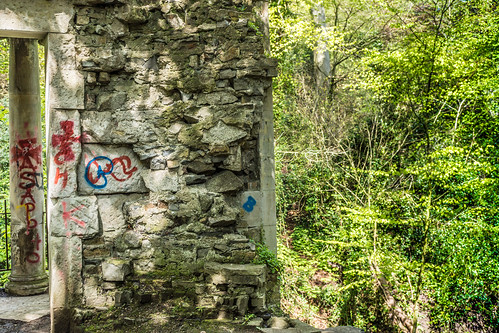
The follies (all of which are in very poor condition) In St. Anne's Park, a photo by infomatique on Flickr.
Today the weather was beautiful so i decided to get the 130 bus to St. Annes's park but I also visited Bull Island, Dollymount Strand, Clontarf, the East Wall Road and the Point Depot from where where I got the Luas tram home.
St Anne's Park is the second largest municipal park in Dublin, is part of a former 202 hectares (500 acres) estate assembled by members of the Guinness family, beginning with Benjamin Lee Guinness in 1835 (the largest municipal park is nearby North Bull Island, also shared between Clontarf and Raheny).
The park has a number of features, from the small Naniken River to the Duck Pond, a number of follies, a walled garden, and grand avenue, all built by the Guinness family, and from more modern times, a rockery, a famous Rose Garden and newer miniature rose garden, and Dublin's city arboretum, with 1,000 varied trees.
The follies (all of which are in very poor condition) include a Herculanean Temple on the banks of the Duck Pond and a viewing tower (once part of the estate's mansion house) and three fortifications. An ornamental bridge high over the Naniken River had its central portion removed in the 1980s, though the Roman-style building at the mansion-side landing point remains, while a "Druidic Circle" of Giant's Causeway basalt was lost at an earlier stage. The viewing tower has been closed for many years.
Dollymount is a coastal suburban area on the north coast of Dublin Bay, within Clontarf, on the northside of Dublin, just East of St Anne's Park.
The famous Wooden Bridge from Clontarf links to Bull Island and the 5 kilometres long stretch of sandy beach and dunes on the island's eastern shore; while the island is located in Clontarf and Raheny, the beach is called Dollymount Strand.
Bull Island or more properly North Bull Island is an island located in Dublin Bay about 5 km long and 800 m wide, lying roughly parallel to the shore off Clontarf (including Dollymount), Raheny, Kilbarrack, and facing Sutton. The island, with a sandy beach running its entire length, is a relatively recent, and inadvertent, result of human intervention in the bay.
No comments:
Post a Comment